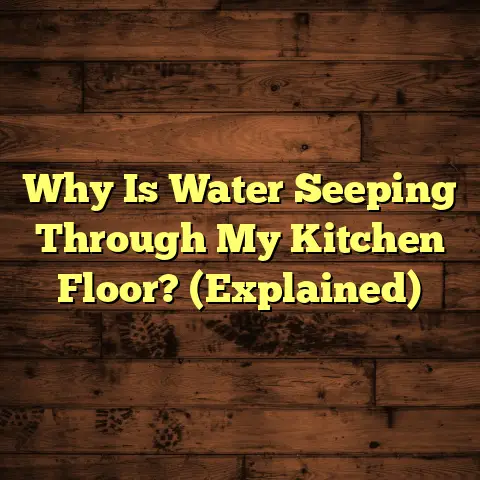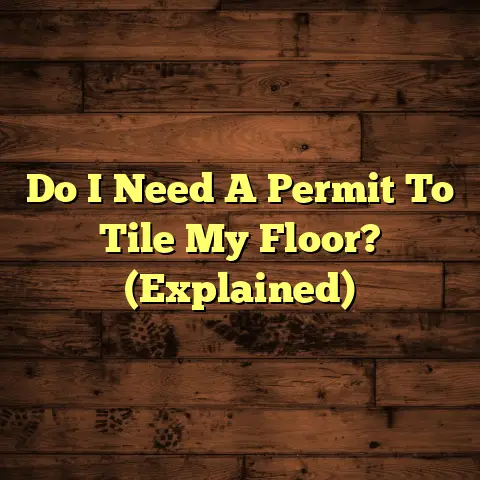Epoxy Class: 1 or 2? (10 Install Red Flags!)
And let me tell you, I’ve seen it all when it comes to epoxy flooring – the good, the bad, and the downright ugly.
Epoxy is like the chameleon of flooring, right? You can customize it to fit just about any space, from your sleek modern kitchen to a heavy-duty industrial warehouse.
Think vibrant colors, metallic swirls, or even embedding objects right into the floor!
That’s why it’s such a popular choice. But here’s the thing: not all epoxy is created equal, and a flawless finish hinges on more than just picking a cool color.
That’s where “Epoxy Class” comes in. And trust me, understanding this concept is key to avoiding a flooring disaster.
So, grab a coffee, settle in, and let’s dive into the world of epoxy, focusing on Class 1 vs. Class 2 and those all-important red flags that can signal a botched installation.
Section 1: Understanding Epoxy Classifications
Okay, so what do I mean by “Epoxy Class 1” and “Epoxy Class 2?” Well, these aren’t official industry terms you’ll find in a textbook.
Instead, think of them as a way to broadly categorize epoxy flooring systems based on their performance characteristics and, more importantly, the level of skill and materials required for a proper install.
Epoxy Class 1:
I consider these to be your high-performance, industrial-grade systems.
We’re talking about epoxies designed to withstand heavy foot traffic, chemical spills, and the daily grind of demanding environments.
Think factories, warehouses, airplane hangars, and even some commercial kitchens.
- Composition: Typically, Class 1 epoxies are multi-component systems, often involving a primer, a body coat (sometimes multiple layers), and a topcoat for added protection.
- Durability: These are the workhorses of the epoxy world. They offer superior resistance to abrasion, impact, and chemical attack.
- Application Methods: Installation requires specialized equipment, like walk-behind grinders for surface prep and professional-grade mixing and application tools.
- Usage Scenarios: Ideal for environments where durability and chemical resistance are paramount.
Epoxy Class 2:
This is where things get a little more flexible. Class 2 epoxies are generally less demanding in terms of performance and are often used in residential or light commercial settings.
Think garages, showrooms, retail spaces, and even some basements.
- Composition: These systems are often simpler, sometimes involving just a single coat or two.
- Durability: While still durable, Class 2 epoxies don’t offer the same level of resistance as Class 1.
- Application Methods: Installation can sometimes be done with simpler tools, though proper surface prep is still crucial.
- Usage Scenarios: Suitable for areas with moderate foot traffic and less exposure to harsh chemicals.
Why Does the Class Matter?
Choosing the right class is all about matching the flooring system to the environment.
Putting a Class 2 epoxy in a factory setting is just asking for trouble – you’ll end up with scratches, chips, and a floor that needs constant repair.
Conversely, using a Class 1 epoxy in your home garage might be overkill and could end up costing you more than necessary.
Here’s a quick table to illustrate the key differences:
| Feature | Epoxy Class 1 | Epoxy Class 2 |
|---|---|---|
| Composition | Multi-component | Simpler, often single-coat |
| Durability | High | Moderate |
| Application | Specialized equipment | Simpler tools (sometimes) |
| Usage | Industrial/Heavy Commercial | Residential/Light Commercial |
| Cost | Higher | Lower |
Ultimately, understanding these classifications helps you make an informed decision and ensures that your epoxy floor will stand the test of time.
Section 2: The Importance of Proper Installation
Okay, let’s talk about installation. You might think, “Hey, it’s just pouring some stuff on the floor, right?”
Wrong! Proper installation is absolutely critical for the performance of any epoxy floor, regardless of its class.
Think of it like building a house. You can have the best materials in the world, but if the foundation is shoddy, the whole thing will crumble.
The same goes for epoxy.
- Longevity: A properly installed epoxy floor can last for years, even decades. But a poorly installed one? You might be looking at repairs or even a complete replacement within a year or two.
- Appearance: Nobody wants a floor with bubbles, uneven patches, or visible imperfections. Proper installation ensures a smooth, seamless finish that looks fantastic.
- Safety: Believe it or not, a bad epoxy job can actually be a safety hazard. Uneven surfaces can create tripping hazards, and poor adhesion can lead to delamination, which can be dangerous.
Common Installation Methods:
While the specifics can vary depending on the epoxy system and the environment, here’s a general overview of the steps involved in a typical epoxy installation:
- Surface Preparation: This is the most important step! It involves cleaning, grinding, and profiling the concrete to ensure proper adhesion.
- Priming (Optional): Some systems require a primer to further enhance adhesion.
- Mixing: The epoxy components (resin and hardener) must be mixed thoroughly and in the correct ratios.
- Application: The epoxy is applied using rollers, squeegees, or other specialized tools.
- Curing: The epoxy needs time to cure properly, which can take anywhere from 24 hours to several days.
- Topcoat (Optional): A topcoat can be applied for added protection and durability.
Each of these steps requires careful attention to detail and adherence to the manufacturer’s instructions. And that brings us to the red flags…
Section 3: 10 Install Red Flags
Alright, let’s get down to the nitty-gritty. Here are 10 red flags that should send you running for the hills when it comes to epoxy flooring installation:
-
Inadequate Surface Preparation
This is, without a doubt, the biggest mistake I see. Think of your concrete floor as a sponge. If it’s covered in dirt, grease, or old coatings, the epoxy won’t be able to soak in and bond properly.
- The Problem: Poor adhesion, leading to peeling, bubbling, and premature failure.
- What to Look For:
- Contractor skipping the grinding or shot blasting step.
- Not properly cleaning the surface with a degreaser or acid etch.
- Ignoring cracks or imperfections in the concrete.
- Adequate Surface Prep: Should involve thorough cleaning, grinding to create a profile (think of it as giving the concrete “teeth” for the epoxy to grip), and repairing any cracks or damage.
-
Poor Quality Materials
Look, I get it. Everyone wants to save money. But skimping on the epoxy itself is a recipe for disaster. Cheaper epoxies often have lower solids content, weaker chemical resistance, and a shorter lifespan.
- The Problem: A floor that’s easily scratched, stained, or damaged.
- What to Look For:
- Contractor using generic or no-name epoxy brands.
- Epoxy with a very thin consistency.
- Lack of information about the epoxy’s specifications.
- High-Quality Materials: Should come from a reputable manufacturer and be specifically designed for the intended application.
-
Incorrect Mixing Ratios
Epoxy is a chemical reaction. You need to mix the resin and hardener in precisely the right proportions for it to cure properly. Too much of one or the other, and you’ll end up with a sticky, gummy mess or a floor that never fully hardens.
- The Problem: Improper curing, leading to a soft, tacky, or brittle floor.
- What to Look For:
- Contractor not using accurate measuring tools.
- Mixing by “feel” instead of following the manufacturer’s instructions.
- Inconsistent mixing times.
- Correct Mixing: Requires precise measuring (using scales or calibrated containers) and thorough mixing with a mechanical mixer for the recommended time.
-
Environmental Conditions
Temperature and humidity can have a huge impact on the curing process. Too cold, and the epoxy might not cure properly. Too humid, and you could end up with a cloudy or hazy finish.
- The Problem: Slow curing, poor adhesion, and an uneven finish.
- What to Look For:
- Installing epoxy in extremely hot or cold weather.
- Ignoring humidity levels.
- Not properly ventilating the area.
- Ideal Conditions: Generally, epoxy should be installed in temperatures between 60°F and 80°F with low humidity.
-
Lack of Experience
Epoxy installation is a skill. It takes practice and knowledge to get it right. Hiring an inexperienced contractor is like letting a novice pilot fly a plane – it might take off, but the landing could be rough.
- The Problem: A poorly installed floor with bubbles, imperfections, and a compromised lifespan.
- What to Look For:
- Contractor with no portfolio or references.
- Reluctance to answer questions about their experience.
- Unprofessional demeanor.
- Experienced Contractor: Should have a proven track record, a portfolio of successful projects, and a thorough understanding of epoxy installation techniques.
-
Inconsistent Application Techniques
The way you apply the epoxy can make a big difference. Using the wrong roller, applying too much or too little epoxy, or not maintaining a wet edge can all lead to an uneven finish and compromised durability.
- The Problem: An uneven floor with visible roller marks, dry spots, and inconsistent thickness.
- What to Look For:
- Contractor using cheap or inappropriate rollers.
- Applying epoxy in a haphazard manner.
- Not maintaining a consistent wet edge.
- Proper Application: Requires using the correct tools, applying the epoxy in even coats, and maintaining a wet edge to ensure a seamless finish.
-
Ignoring Manufacturer Guidelines
Every epoxy system is different. The manufacturer provides specific instructions for mixing, application, and curing. Ignoring these guidelines is like trying to bake a cake without following the recipe – you’re unlikely to get the desired result.
- The Problem: A floor that doesn’t cure properly, has poor adhesion, or fails prematurely.
- What to Look For:
- Contractor not reading or following the manufacturer’s instructions.
- Deviating from the recommended mixing ratios or curing times.
- Using incompatible products.
- Adherence to Guidelines: Requires carefully reading and following the manufacturer’s instructions for every step of the process.
-
Failure to Address Moisture Issues
Concrete is porous, and moisture can wick up from the ground. If you install epoxy over concrete with high moisture content, the moisture can get trapped underneath, leading to bubbling, peeling, and adhesion failure.
- The Problem: Bubbling, peeling, and adhesion failure due to trapped moisture.
- What to Look For:
- Contractor not performing a moisture test before installation.
- Ignoring signs of moisture, such as dampness or efflorescence (a white, powdery substance on the concrete surface).
- Not using a moisture barrier if necessary.
- Addressing Moisture: Requires performing a moisture test (such as a calcium chloride test) to determine the moisture content of the concrete and using a moisture barrier if necessary.
-
Neglecting Safety Precautions
Epoxy is a chemical product, and it can be harmful if not handled properly. Proper ventilation, protective clothing, and eye protection are essential to protect yourself from fumes and skin contact.
- The Problem: Exposure to harmful chemicals, leading to skin irritation, respiratory problems, and other health issues.
- What to Look For:
- Contractor not wearing proper protective gear (gloves, respirator, eye protection).
- Poor ventilation in the work area.
- Lack of awareness of safety hazards.
- Safety Measures: Should include wearing appropriate protective gear, ensuring adequate ventilation, and following all safety guidelines provided by the manufacturer.
-
Insufficient Curing Time
Epoxy needs time to fully cure and harden. Rushing the process by walking on the floor too soon or exposing it to heavy traffic can damage the surface and compromise its durability.
- The Problem: A soft, easily damaged floor.
- What to Look For:
- Contractor not allowing adequate curing time.
- Walking on the floor before it’s fully cured.
- Exposing the floor to heavy traffic or chemicals too soon.
- Adequate Curing Time: Should be determined by the manufacturer’s instructions and can range from 24 hours to several days.
Section 4: Conclusion
So, there you have it – a deep dive into the world of epoxy flooring, focusing on the (unofficial) classifications and those all-important red flags.
Remember, epoxy can be an amazing flooring solution, offering incredible durability, versatility, and aesthetic appeal. But it’s not a magic bullet.
A successful epoxy installation requires careful planning, high-quality materials, and, most importantly, a skilled and experienced contractor who pays attention to detail.
Don’t be afraid to ask questions, do your research, and be vigilant about those red flags.
By being proactive, you can ensure that your epoxy floor will not only look fantastic but also stand the test of time.
And hey, if you ever have any questions or need some advice, feel free to reach out. I’m always happy to share my knowledge and help you avoid a flooring faux pas!





